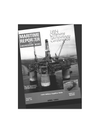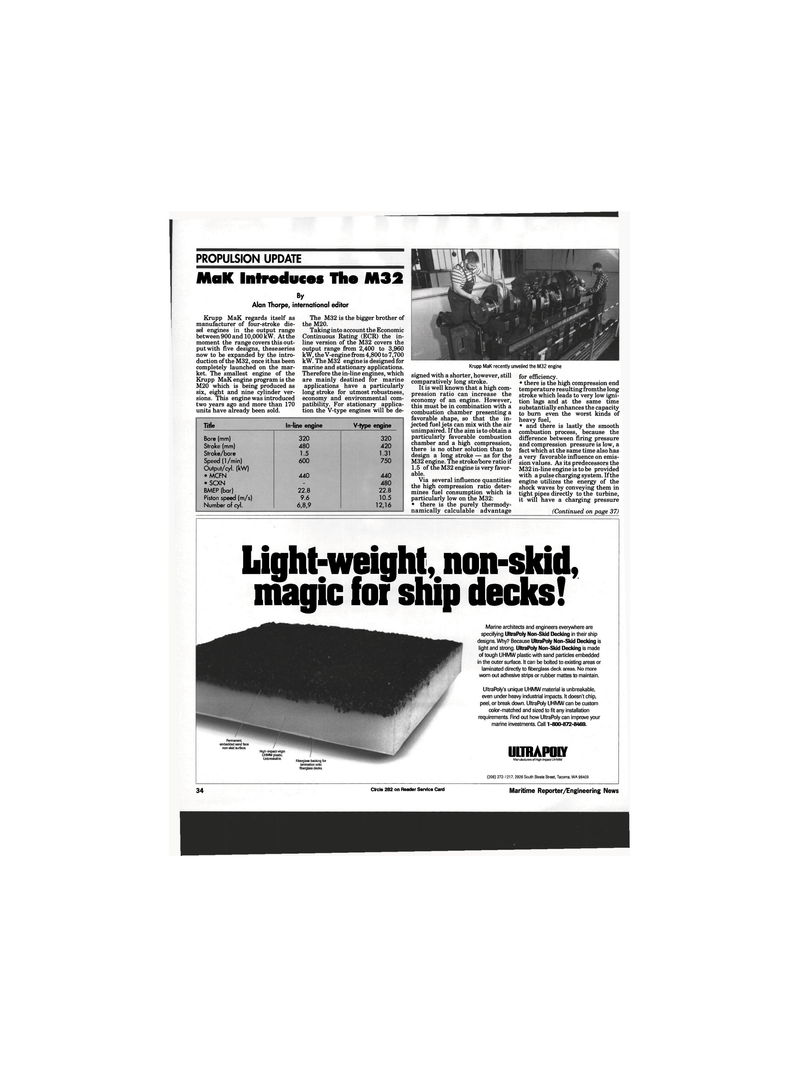
Page 32: of Maritime Reporter Magazine (April 1994)
Read this page in Pdf, Flash or Html5 edition of April 1994 Maritime Reporter Magazine
Title In-line engine V-type engine
Bore (mm) 320 320
Stroke (mm) 480 420
Stroke/bore 1.5 1.31
Speed (1/min) 600 750
Output/cyl. (kW) • MCFN 440 440 • SCXN - 480
BMEP (bar) 22.8 22.8
Piston speed (m/s) 9.6 10.5
Number of cyl. 6,8,9 12,16
Light-weight, non-skid, magic for ship decks!
PROPULSION UPDATE
MaK Introduces The M32
By
Alan Thorpe, international editor
Krupp MaK regards itself as manufacturer of four-stroke die- sel engines in the output range between 900 and 10,000 kW. At the moment the range covers this out- put with five designs, these series now to be expanded by the intro- duction of the M32, once ithas been completely launched on the mar- ket. The smallest engine of the
Krupp MaK engine program is the
M20 which is being produced as six, eight and nine cylinder ver- sions. This engine was introduced two years ago and more than 170 units have already been sold.
The M32 is the bigger brother of the M20.
Taking into account the Economic
Continuous Rating (ECR) the in- line version of the M32 covers the output range from 2,400 to 3,960 kW, the V-engine from 4,800 to 7,700 kW. The M32 engine is designed for marine and stationary applications.
Therefore the in-line engines, which are mainly destined for marine applications have a particularly long stroke for utmost robustness, economy and environmental com- patibility. For stationary applica- tion the V-type engines will be de-
Krupp MaK recently unveiled the M32 engine signed with a shorter, however, still comparatively long stroke.
It is well known that a high com- pression ratio can increase the economy of an engine. However, this must be in combination with a combustion chamber presenting a favorable shape, so that the in- jected fuel jets can mix with the air unimpaired. If the aim is to obtain a particularly favorable combustion chamber and a high compression, there is no other solution than to design a long stroke — as for the
M32 engine. The stroke/bore ratio if 1.5 of the M32 engine is very favor- able.
Via several influence quantities the high compression ratio deter- mines fuel consumption which is particularly low on the M32: • there is the purely thermody- namically calculable advantage for efficiency. • there is the high compression end temperature resulting fromthe long stroke which leads to very low igni- tion lags and at the same time substantially enhances the capacity to burn even the worst kinds of heavy fuel, • and there is lastly the smooth combustion process, because the difference between firing pressure and compression pressure is low, a fact which at the same time also has a very favorable influence on emis- sion values. As its predecessors the
M32 in-line engine is to be provided with a pulse charging system. If the engine utilizes the energy of the shock waves by conveying them in tight pipes directly to the turbine, it will have a charging pressure (Continued on page 37)
Marine architects and engineers everywhere are specifying UltraPoly Non-Skid Decking in their ship designs. Why? Because UltraPoly Non-Skid Decking is light and strong. UltraPoly Non-Skid Decking is made of tough UHMW plastic with sand particles embedded in the outer surface. It can be bolted to existing areas or laminated directly to fiberglass deck areas. No more worn out adhesive strips or rubber mattes to maintain.
UltraPoly's unique UHMW material is unbreakable, even under heavy industrial impacts. It doesn't chip, peel, or break down. UltraPoly UHMW can be custom color-matched and sized to fit any installation requirements. Find out how UltraPoly can improve your marine investments. Call 1-800-872-8469.
UliRAPOIV
Manufacturers of High-Impact UHMW (206) 272-1217,2926 South Steele Street. Tacoma, WA 98409
Permanent, embedded sand face non-skid surface.
High-impact virgin
UHMW plastic.
Unbreakable. Fiberglass backing for lamination onto fiberglass decks. 34 Circle 282 on Reader Service Card Maritime Reporter/Engineering News

 31
31

 33
33
